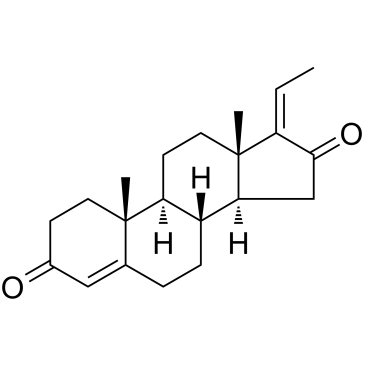Home
Products
Guggulsterone E&Z



| Product Name | Guggulsterone E&Z |
| Price: | $62 / 20mg |
| Catalog No.: | CN02407 |
| CAS No.: | 95975-55-6 |
| Molecular Formula: | C21H28O2 |
| Molecular Weight: | 312.5 g/mol |
| Purity: | >=98% |
| Type of Compound: | Steroids |
| Physical Desc.: | Powder |
| Source: | The herbs of Ailanthus grandis |
| Solvent: | Chloroform, Dichloromethane, Ethyl Acetate, DMSO, Acetone, etc. |
| SMILES: | CC=C1C(=O)C[C@@H]2[C@]1(C)CC[C@H]1[C@H]2CCC2=CC(=O)CC[C@]12C |
| Contact us | |
|---|---|
| First Name: | |
| Last Name: | |
| E-mail: | |
| Question: | |
| Description | Guggulsterone is a plant sterol derived from the gum resin of the tree Commiphora wightii. Guggulsterone inhibits the growth of a wide variety of tumor cells and induces apoptosis through down regulation of antiapoptotic gene products (IAP1, xIAP, Bfl-1/A1, Bcl-2, cFLIP and survivin), modulation of cell cycle proteins (cyclin D1 and c-Myc), activation of caspases and JNK, inhibition of Akt[1]. Guggulsterone, a farnesoid X receptor (FXR) antagonist, decreases CDCA-induced FXR activation with IC50s of 17 and 15 μM for Z- and E-Guggulsterone, respectively[2]. |
| Target | JNK Akt Caspase |
| In Vitro | Guggulsterone (0.5-20 μM; 24 hours) suppresses TREM-1, TLR4 and TNF-α expression as well as the phosphorylation of IκBα and NF-κB p65 by LPS[2]. Western Blot Analysis[1] Cell Line: RAW 264.7 murine macrophage cells Concentration: 0.5, 5, 10, 20 μM Incubation Time: 24 hours Result: Suppressed TREM-1, TLR4, and TNF-α expression as well as the phosphorylation of IκBα and NF-κB p65 by LPS. |
| In Vivo | Guggulsterone (orally; 100 mg/kg once per day for 8 days) significantly improved the survival rates of wild-type mice with TNBS-induced colitis[2]. Animal Model: Wild-type mice with TNBS-induced colitis[2] Dosage: 100 mg/kg Administration: Orally; once per day; for 8 days Result: Improved the survival rates of wild-type mice with TNBS-induced colitis. |
| Density | 1.1±0.1 g/cm3 |
| Boiling Point | 463.3±45.0 °C at 760 mmHg |
| Flash Point | 172.3±25.7 °C |
| Exact Mass | 312.208923 |
| PSA | 34.14000 |
| LogP | 3.65 |
| Vapour Pressure | 0.0±1.1 mmHg at 25°C |
| Storage condition | 2-8°C |